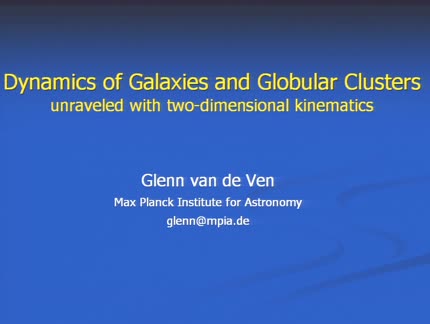Found 3 talks width keyword SAURON

Abstract
Two-dimensional stellar kinematics obtained with the integral-field spectrograph SAURON allow the classification of early-type galaxies into 'slow' and 'fast' rotators, different from their morphological classification into ellipticals and lenticulars. Most fast rotators, including lenticular as well as many elliptical galaxies, are consistent with oblate axisymmetric disk-like systems. On the other hand, the slow-rotator ellipticals show clear deviations from axisymmetry, which can be modeled with our extension of Schwarzschild's orbit superposition method to triaxial geometry. Besides galaxies, I show that Schwarzschild's method can also be used to model in detail globular clusters such as ω Cen and M15. The recovered internal orbital structure of ω Cen reveals besides a signature of tidal interaction, also a central stellar disk, supporting its origin as the nucleus of a stripped dwarf galaxy. The formally best-fit Schwarzschild model for M15 includes an intermediate-mass black hole, but we cannot exclude a model in which dark remnants make up the dark mass in the collapsed core.

Abstract
The SAURON survey has revised our view of early type galaxies discovering that central disks and multiple kinematic components are common; 75% of the sample have extended ionized gas, often misaligned with the stars; half of S0s and 25% of Es have intermediate age populations. There is a tight relationship between the escape velocity and Mg line strength which holds both within and between galaxies raising uncomfortable questions for hierarchical assembly. Many of the properties of ETGs are related to a measure of their specific angular momentum : slow rotators are triaxial, close to spherical, isotropic and frequently exhibit decoupled central kinematics, whereas fast rotators are intrinsically flatter, oblate, have disk-like (anisotropic) kinematics and often have Mg enhanced disks. In general the slow rotators are more massive and have older populations Only half of the elliptical galaxies exhibit slow rotation, the remainder have stellar disks showing that the historic division by morphological class is physically misleading. We suggest that the contrasting physical properties of fast and slow rotators arise through distinct assembly histories with slow rotators forming in gas free, dry mergers and fast rotators retaining a disk component through a dissipative merger.
Abstract
From galaxy formation theory we expect galaxies to be embedded in massive dark matter haloes. For spiral and dwarf galaxies this has indeed been observationally confirmed, by modeling the kinematics from the large cold gas discs that often surround these galaxies. These gas discs are however rare in elliptical galaxies, so that we have to resort to other tracers when we want to probe their dark matter haloes, which are not always easily accessible. As a result, dark haloes for only a handful of early-type galaxies have been mapped. In this talk I will give an overview of the methods that can be used to find dark matter in early-type galaxies. I will then focus on two projects that I worked on with the integral-field spectrograph SAURON, using two different methods to constrain the dark halo. The first is based on the combination of two-dimensional ionised gas and cold gas kinematics. The second method uses SAURON as a 'photon collector', to obtain spectra at large radii in galaxies. From these spectra we can not only obtain the velocity profile and construct mass models to constrain the dark halo, but also infer the properties of the stellar halo population. I will show the results from these two projects and discuss some future prospects.« Newer Older »
Próximas charlas
- Classical Be stars - Constraining binary interaction physics in massive starsDr. Julia BodensteinerThursday April 25, 2024 - 10:30 GMT+1 (Aula)
- Runaway O and Be stars found using Gaia DR3, new stellar bow shocks and search for binariesMar Carretero CastrilloTuesday April 30, 2024 - 12:30 GMT+1 (Aula)








